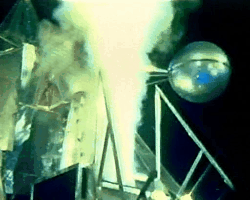Author Archives: saucerkommand
alexandriasays: A Tribe Called Quest – Luck of Lucien
Today in Hip Hop History:
Today in Hip Hop History:
A Tribe Called Quest released their debut album People’s Instinctive Travels And The Paths Of Rhythm April 10, 1990
disease: MADVILLAIN // SCENE THREE[CURLS & ALL CAPS, 2004]
Photo

I feel confident enough to post these now. A collection of all the existing posters after some edits…
I feel confident enough to post these now. A collection of all the existing posters after some edits from the other post that got 13k notes! These are full size/quality. Go nuts.
You may use them for wallpapers, tabletop campaigns, whatever. Consider tipping me or buying a print or sticker on ko-fi here! If you do use them, let me know what for, or send pictures!
SAUCERKOMMAND 2024-04-09 14:04:48
this-is-cool:The iconic science fiction themed artworks of of…










The iconic science fiction themed artworks of of Pascal Blanché - https://www.this-is-cool.co.uk/the-iconic-sci-fi-artworks-of-pascal-blanche/
color-palettes:Burning Up – Submitted by…
Jahari Massamba Unit – Boppin’ (Law of Rhythm)
Jahari Massamba Unit - Boppin’ (Law of Rhythm)
Open Drums, 2024.
MADLIB & Karriem Riggins project.
Photo

saucerkommand: I’ll Wait For You, Sun RaStrange Celestial Road
Zana Santos by Fernando Tomaz for Vogue Brasil September 2023
Zana Santos by Fernando Tomaz for Vogue Brasil September 2023
WR 25 & Tr16-244 in Carina Nebula © Hubble
WR 25 & Tr16-244 in Carina Nebula © Hubble
Bastet Study 1 (2021) by British sculptor, Nichola Theakston (born in 1967).
Bastet Study 1 (2021) by British sculptor, Nichola Theakston (born in 1967).
Bronze 27 x 16 x 14 cm, 11 x 6.5 x 5.5 in approx
robertocustodioart: Nyagua Ruea by Rafael Pavarotti 2021
Total eclipse of the Sun, July 1860, illustrated by astronomer Warren de la Rue.
Total eclipse of the Sun, July 1860, illustrated by astronomer Warren de la Rue.
On Monday, April 8, 2024, there’ll be a total solar eclipse – and it’ll be the last one to cross…
nasa:
2024 Total Solar Eclipse: Through the Eyes of NASA (Official Broadcast)
On Monday, April 8, 2024, there’ll be a total solar eclipse – and it’ll be the last one to cross North America for 20 years. Make sure you’re tuned in to our live broadcast for this exciting event: there’ll be views from along the path of totality, special guests, and plenty of science.
Make sure to follow us on Tumblr for your regular dose of space!
nevver:Believe in me, Chris Austin
occvltswim: Le Matin des magiciens
SAUCERKOMMAND 2024-04-07 20:24:25
Nyaduola Gabriel by Anthony Arquier for Numéro France April 2024
Nyaduola Gabriel by Anthony Arquier for Numéro France April 2024
Joana Dacheville (Fashion Editor/Stylist), Yumiko Hikage (Hair Stylist), Marielle Loubet (Makeup Artist), Magda S (Manicurist)
est-nord: img:…
jewel caterpillar (minacraga argentata) | source
jewel caterpillar (minacraga argentata) | source
💚🌳🌲💚🌳🌲💚🌳🌲💚🌳🌲💚🌳🌲💚🌳🌲
💚🌳🌲💚🌳🌲💚🌳🌲💚🌳🌲💚🌳🌲💚🌳🌲
Hey my love, I see you 💚 and I know you see me
Come with me? I want to show you something 🌳
Let me look around a bit; sense where we are
Feel free to lay in the grass; you’re safe with me
💚🌳🌲💚🌳🌲💚🌳🌲💚🌳🌲💚🌳🌲💚🌳🌲
SAUCERKOMMAND 2024-04-07 12:54:17
blumarine fall/winter 2021 campaign
blumarine fall/winter 2021 campaign
Photo

Photo

SAUCERKOMMAND 2024-04-07 12:27:56
SAUCERKOMMAND 2024-04-06 06:57:00
Menzel 2: goodbye from a dying star © Hubble
Menzel 2: goodbye from a dying star © Hubble
neocitys:CHLOE X HALLEUngodly Hour, 2021
Magic: The Gathering Liquid Starlight Basic Lands Purchase them to print on your own as proxies!
Magic: The Gathering Liquid Starlight Basic Lands
Purchase them to print on your own as proxies!
SAUCERKOMMAND 2024-04-05 10:52:03
Looking Glass.
SAUCERKOMMAND 2024-04-05 10:08:47
Luca Oleastri
Luca Oleastri
Storm by JSway Art
Storm by JSway Art
NOPE (2022) dir. Jordan Peele
NOPE (2022) dir. Jordan Peele
Photo

Photo

nevver:The lost world, Michael Kerbow
ofallingstar: The Antique (2018)
fyblackwomenart: “Alrighty Aphrodite ” by Saint Hedge
Cosmic Sunset- Jin Dot
Cosmic Sunset- Jin Dot
SAUCERKOMMAND 2024-04-03 16:48:25
talonabraxas: The Infinite Soul 𝐁𝐫𝐚𝐧𝐝𝐨 ☥
Chromatic Inferno.
TYLA IN VENUS (2024) @tyla
Stellar spire in the Eagle Nebula.
ALT
Stellar spire in the Eagle Nebula.
Credit: NASA, ESA, and The Hubble Heritage Team (STScI/AURA).
parliamentfunkadelic:Dr. Funkenstein yall.
2024 March 22
2024 March 22
Phobos: Moon over Mars
Image Credit: NASA, ESA, Zolt Levay (STScI) - Acknowledgment: J.Bell (ASU) and M.Wolff (SSI)
Explanation: A tiny moon with a scary name, Phobos emerges from behind the Red Planet in this timelapse sequence from the Earth-orbiting Hubble Space Telescope. Over 22 minutes the 13 separate exposures were captured near the 2016 closest approach of Mars to planet Earth. Martians have to look to the west to watch Phobos rise, though. The small moon is closer to its parent planet than any other moon in the Solar System, about 3,700 miles (6,000 kilometers) above the Martian surface. It completes one orbit in just 7 hours and 39 minutes. That’s faster than a Mars rotation, which corresponds to about 24 hours and 40 minutes. So on Mars, Phobos can be seen to rise above the western horizon 3 times a day. Still, Phobos is doomed.
SAUCERKOMMAND 2024-04-02 21:21:16
Photo

psikonauti: Isaac Abrams (American, b. 1939)Psychedelic…
Author’s Instagram: Silvana Mendes

Author’s Instagram: Silvana Mendes
Claudia Griesbach-Martucci – In Good Company, 2023
Claudia Griesbach-Martucci - In Good Company, 2023
SAUCERKOMMAND 2024-04-02 14:38:34
Evangelos Faeinos (1918-1985) — Fruits [acrylic, charcoal, and mixed media on panel, 1976-1978]
Evangelos Faeinos (1918-1985) — Fruits [acrylic, charcoal, and mixed media on panel, 1976-1978]
SAUCERKOMMAND 2024-04-02 12:19:05
The Goddess Nekhbet, Temple of Hatshepsut, New Kingdom, ca. 1479-1458 B.C., Charles K. Wilkinson…
The Goddess Nekhbet, Temple of Hatshepsut, New Kingdom, ca. 1479-1458 B.C., Charles K. Wilkinson Illustration
Facsimile of a falcon protecting the king, New Kingdom, ca. 1479-1458 B.C., Charles K. Wilkinson Illustration
“Forbidden knowledge” Anthony Machuca
“Forbidden knowledge”
Anthony Machuca
70sscifiart: Bruce Pennington
SAUCERKOMMAND 2024-04-02 11:15:03
Neptune Planet
Neptune Planet
SAUCERKOMMAND 2024-04-01 21:41:24
Yemanjá, Rafa Cotrim

Yemanjá, Rafa Cotrim
steampunktendencies:“Self Organization”, aka, The octopus…

www.steampunktendencies.com

www.steampunktendencies.com

www.steampunktendencies.com

www.steampunktendencies.com
“Self Organization”, aka, The octopus sculpture Bronze, 3'x3’, found typewriter by Oakland artist Courtney Brown
(via Colossal)
🪼 | source
🪼 | source
Shades of Azul 877, Saatchi Art

Shades of Azul 877, Saatchi Art
spacewonder19: Full Moon in April by astrofalls
wonders-of-the-cosmos: Conjunction: Jupiter and Saturn…
She Who Holds The Light, Manzel Bowman

She Who Holds The Light, Manzel Bowman
WR 128 (center) and Sh2-84 (upper left) // Jerry Yesavage
WR 128 (center) and Sh2-84 (upper left) // Jerry Yesavage
Photo

‘alta moda’ by andrea brocca.
‘alta moda’ by andrea brocca.
achai maper. 📸 daniel archer.
70sscifiart: Art for ‘Close Encounters of the Third Kind,’ by…
oninoheizo:Toshiba Transistor Radio model 6TR-92 “The Rice…
Photo

fyblackwomenart: “Rihanna” by Laura H. Rubin
unexplained-events: Jellyfish SpriteRed sprites or the…

Jellyfish Sprite
Red sprites or the tentacle-like spurts of red lightning in the sky during a storm are sometimes referred to as Jellyfish Sprite (because of their shape). There are also some that are vertical columns of red light and those are called carrot sprites.
They are ultra fast electricity traveling through the atmosphere towards space and are extremely rare (they last a tenth of a second). They can also be seen from space.
The picture above was captured on Mt. Locke in Texas (July 2nd, 2020) by Stephen Hummel.
Andreea Dumuta
Andreea Dumuta
Adut Akech by Chris Colls for Elle US Magazine, August 2021.
Adut Akech by Chris Colls for Elle US Magazine, August 2021.
Photo

Photo

The Nebulae of Auriga Widefield (Flaming Star, IC 410, Spider Nebula, Fly Nebula)
The Nebulae of Auriga Widefield (Flaming Star, IC 410, Spider Nebula, Fly Nebula)
Left Eye for No Scrubs
Left Eye for No Scrubs
talesfromweirdland: City of the future: retro sci-fi art by…







City of the future: retro sci-fi art by illustrator John Berkey (1932-2008).
Most of these were published in Popular Mechanics, I think; but Berkey also did a series of Otis ads.
Photo

Photo

SAUCERKOMMAND 2024-03-27 15:14:55
color-palettes: Journeys to Jupiter – Submitted by…
SAUCERKOMMAND 2024-03-27 14:09:47
world-beauty: The Dark River to Antares Credits: Jason Jennings
SAUCERKOMMAND 2024-03-26 18:05:49
Photo

SAUCERKOMMAND 2024-03-26 00:36:27
Photo



































































































































